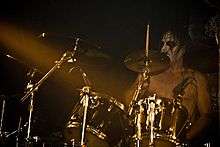Inquisition (metal band)
Inquisition is an American black metal band that formed in Cali, Colombia in 1988 and later relocated to Seattle, Washington. The band possessed a thrash metal sound on its earliest recordings, but began incorporating more black metal influences in 1996 with its first extended play (EP), Incense of Rest.[1]
Inquisition | |
|---|---|
 Live at Hole in the Sky, Bergen Metal Fest 2008 | |
| Background information | |
| Origin | Cali, Colombia |
| Genres | Black metal, thrash metal (early) |
| Years active | 1988–present |
| Labels | Sylphorium, Defiled, War Hammer, Nuclear War Now!, No Colours, Season of Mist |
| Members | Dagon Incubus |
History

Inquisition was formed in 1988 in Cali, Colombia, by Dagon as a thrash metal act named Guillotine.[2] The band changed their name to Inquisition in 1989. The name, frontman Dagon later explained, was chosen because it represented humanity's "need to establish dominance, control and order based on a particular period of our world's history."[3] Dagon viewed this historical event as emblematic of "man's [general] need to impose his rule over others."[3] In 1996, Dagon relocated to the United States and recruited Incubus on drums and Debandt on bass.[4] Debandt departed the band shortly after the release of Inquisition's full-length debut, Into the Infernal Regions of the Ancient Cult.[4] The band chose to remain a two-piece and all subsequent releases were recorded solely by Dagon and Incubus.
Dagon has suggested that the band's formation in Colombia and subsequent development in the United States affected Inquisition's sound. Observing that "Many second and third world countries have an environment in them that suits Black Metal and Death Metal perfectly," Dagon explained that "life in some of them mean nothing. The high social tension and rebellion in those areas of the world only intensify this music and make 'evil' much more of a reality."[5] Recalling "seeing people get shot and stabbed [by] the Cali and Medellin cartel,"[5] Dagon portrayed the environment surrounding the band's formative years as "true darkness in flesh and blood."[5] He described Inquisition as combining "the South American attitude" with "the musicianship and skills of the European scene."[5] Dagon later downplayed geographic and cultural influences in favour of emphasizing the band's metaphysical inspiration: "I don't think of anything particular in our music as being rooted in a particular area culturally. Sure, there can be external influences based on geographical location, or your heritage can play a role, but in this band's case it just doesn't happen. We keep things detached from that and aim for a sound that is inspired from a much more distant and mystical element."[3]
In 2012, the band signed with the French label Season of Mist. The band's label debut, Obscure Verses for the Multiverse, was released on 25 October 2013 (29 October in North America). Their seventh album Bloodshed Across the Empyrean Altar Beyond the Celestial Zenith was released on 26 August 2016.
On 26 March 2018, the band was dropped from a tour with Satyricon as former allegations of child pornography were brought up against Dagon back in 2008. The original charges against him were dropped, however, and the prosecution later offered a plea bargain. Dagon was allowed to profess his innocence in court despite the plea and all charges were later dropped.
Musical style
Inquisition started as a thrash metal band in the vein of Sodom and Kreator,[2] but became increasingly oriented towards black metal. Dagon explained that thrash "had gotten stagnant",[1] which led him towards black metal as it was a "guitar-driven" form of music that did not sound so "dated" and "uninteresting".[1] The band described their sound as black metal with "slow, deep and dark riffing", "sudden tempo changes", and "melodic solo[ing]".[4] These stylistic elements were mixed with "old school thrash metal-influenced riffs", "darker and more chaotic black metal", and "fast, tremolo picked minor-key guitar riffs".[4] The band has cited Bathory's The Return…… as well as the music of Burzum, Immortal and Polish black metal as influential.[5]
Inquisition's recordings have not featured a bass guitar since their debut, Into the Infernal Regions of the Ancient Cult. Dagon explained that he and Incubus "had too many problems finding a bass player years ago" and gave reasons ranging from drug addiction to the absence of a complementary ideological orientation.[5] He said that he plays his guitar in such a way that the bass is unnecessary:
We have the bare minimum needed to create Satanic music in the form of Black Metal: a guitar, drums and a voice. With this simplistic formula, I believe that this adds to the magic of our hymns. You can do so much with so little, it is all about how creative you can or want to be, it is about your capabilities.[5]
Dagon has said that his vocals are intentionally inhuman in order to represent an unseen demonic entity that conveys the lyrical themes. While some critics have described Dagon's singing style as "reptilian",[6] Metal Hammer journalist Robert Müller compared Dagon's voice to Kermit the Frog.[7] Responding to the comparison, Dagon described the intent and history of his approach:
Back in the day when I was thinking about a vocal style for Inquisition, I came to the conclusion that I did not want something screamed out at [the] top [of my] lung[s]. So many people were doing that, and still are, and identity is important to me, so I figured what can I do that the majority are not doing; meanwhile I kept hearing this idea in my head of a spoken like inhuman form of vocals chanting over very heavy and at times fast music creating a contrast. That's why when people say it sounds like a frog or anything else I feel I obtained what I wanted, I achieved that goal of keeping the human factor out of the vocal chants.[6]
Dagon cited early Graveland and Mayhem's De Mysteriis Dom Sathanas as influential to his vocal approach.[1]
Another notable element of the Inquisition sound is Incubus' blast beat style, in which the snare works together with the hi-hat or ride while alternating the two bass drums, as opposed to alternating the snare and kick, the more traditional form. This style is somewhat uncommon in black metal, being used much more prevalently in death metal.
Over time, the band's compositions have become increasingly complex. Dagon has referenced Baroque composers as among his greatest inspirations:
The greatest composers of the Baroque period inspire me a great deal, more so than any other form of music. The flamboyant and excessively tonal and predictable style of that period's music amazes me more than any other period in the universe of music. The Baroque composers took music to a level never seen or heard before, light years ahead of its time, and also served as the core of inspiration and influence on the period that followed. The masters never feared taking expression to the highest levels amidst the complexity of their compositions, and they did not let technique get in the way of feeling. They were perfectly balanced in technique and emotion, two worlds merged into one masterpiece. Music is expression and should be a sophisticated tool for displaying the different levels of the human mind which go unseen.[3]
Religion and ideology
Dagon defines black metal as "music that speaks for Satan, prov[ing] the existence of its force...Black Metal in essence must begin with the recognition of Satan as the foundation of the Black Metal code. This is where Black Metal began and this is how it must be, always, there should be no doubts."[5] He described black metal as Satan expressed "through sound waves"[6] and affirmed "individualism, elitism, rebellion against unnecessary control, pride with a cause" as virtues celebrated by Satanism.[6] Dagon cited "demonic art" such as "old diabolic woodcuts made in times when Satan was a real threat to people" as well as books on the occult, black magic, and demonology as lyrical inspirations.[5] Dagon's lyrics are overtly Satanic, and address both theistic and LaVeyan forms of Satanism, as well as pre-Christian incarnations of evil such as Baphomet, a demon from Babylonian religion.[5]
Over time, Inquisition incorporated increasingly cosmic and metaphysical themes into its music.[6] Dagon confirmed that these themes represent an extension and elaboration of Satanism. For Dagon, the "energy" of Satan is "everywhere", including the "cosmic dust that [forms] the ground we walk on and even who we are. Every cosmic molecule is in you and will eventually crumble and die, recycling itself back with the stars...space in general is simply the most real heaven and the most real hell you will ever come across alive or dead."[6]
Allegations of neo-Nazism
Inquisition has been accused of being a Nazi/white supremacist band or at least having racist band members. Band frontman Jason "Dagon" Weirbach has an electronic/noise side project called 88MM.[8] The project is named after the 8.8 cm Flak 18/36/37/41 artillery weapon employed by Nazi Germany during Spanish Civil War and World War II. 88 is also frequently used by neo-Nazis as a numerical code for "HH," with H represented as the eight letter in the English alphabet, standing for "Heil Hitler."[9][10] 88MM was included on the compilation called "Declaration of Anti-Semetic [sic] Terror" with the track "14 Showerheads, 1 Gas Tight Door". The compilation was released by white supremacist record label Satanic Skinhead Propaganda.[11] Inquisition also appeared on a compilation CD called "From Columbia With Hate" by Sylphorium Records. In the booklet of the CD there is an image of the band in front of a Nazi flag.[12]
Band members
Current
- Dagon – guitars, vocals (1988–present)
- Incubus – drums (1996–present)
Past
- John Santa – drums (1988–1994)
- Endhir Xo Kpurtos – drums (1996)
- Debandt – bass (1998)
- Cesar Santa – bass (1989)
- Carlos Arcila – keyboards, flute
Discography
Full-lengths
- Into the Infernal Regions of the Ancient Cult (1998)
- Invoking the Majestic Throne of Satan (2002)
- Magnificent Glorification of Lucifer (2004)
- Nefarious Dismal Orations (2007)
- Ominous Doctrines of the Perpetual Mystical Macrocosm (2010)
- Obscure Verses for the Multiverse (2013)
- Bloodshed Across the Empyrean Altar Beyond the Celestial Zenith (2016)
Live albums
- Demonic Ritual in Unholy Blackness (2018)
EPs, demos, splits and compilations
- Anxious Death (1990, EP)
- Forever Under (1993, demo)
- Incense of Rest (1996, EP; later released as a split with Profane Creation)
- Summoning the Black Dimensions in the Farallones / Nema (1996, split album with Profane Creation)
- Unholy Inquisition Rites (2004, EP; preview of Magnificent Glorification of Lucifer featuring two raw mixes, a rehearsal track, and a live song)
- Anxious Death/Forever Under (2004, compilation)
References
- "Inquisition (Dagon) Interview". Metal Blast. 16 May 2012. Retrieved 18 January 2014.
- Dagon: Inquisition “Anxious Death/Forever Under” CD Out Now, accessed on 24 February 2013.
- Williams, Rhys (30 October 2013). "Interview: Inquisition's Dagon". Invisible Oranges. Retrieved 19 January 2014.
- Inquisition (OFFICIAL), Myspace.com, accessed on 10 March 2013.
- Daniel: Inquisition - Jun 2005, June 2005, accessed on 10 March 2013.
- "Interview: Inquisition". Thatshowkidsdie.com. 13 February 2011. Archived from the original on 1 February 2014. Retrieved 18 January 2014.
- Robert Müller: Der tote Winkel. Die verflixte 13. In: Metal Hammer, August 2011, p. 103.
- "Racist Skinhead Glossary | Southern Poverty Law Center". Splcenter.org. Retrieved 13 March 2020.
- "88 | Hate Symbols Database". Adl.org. Retrieved 13 March 2020.
- King, Elizabeth (26 September 2017). "How White Supremacists Infiltrated Metal - Pacific Standard". Psmag.com. Retrieved 13 March 2020.
External links
